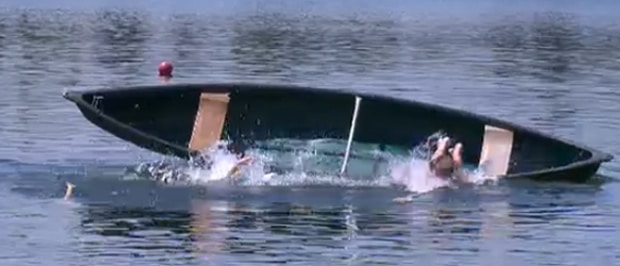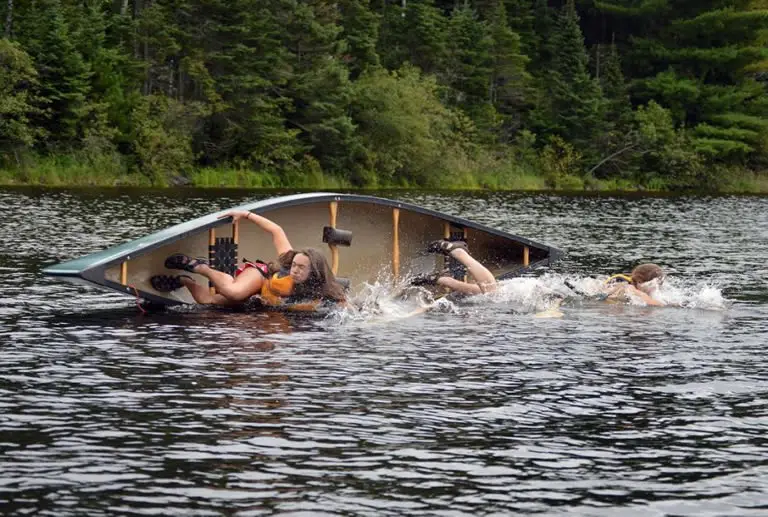Canoeing is a popular water activity among different age groups. It is not difficult to learn how to canoe but one thing canoeists become wary of is capsizing in the water. Here we will outline just how easy or hard it is to tip a canoe.
Contents
- Do Canoes Tip Easily?
- How to Avoid Tipping A Canoe
- What To Do If Your Canoe Tips Over
Do Canoes Tip Easily?
Yes, under certain conditions canoes can tip easily.
There are 5 key causes of tipping, with the most common being due to uneven distribution of weight on the boat.
Canoes are lightweight and are easily influenced by movement, from passengers and also from the water, making them susceptible to tipping.
Using a type of canoe (there are canoes with different hull designs) that is unsuitable for the marine environment you are using it in can also cause tipping concerns.
This is why canoeists must learn how to balance properly while paddling.
However, with a bit of practice and with the proper techniques it is easy to keep your canoe stable and upright.
5 Things that can tip a canoe
Several factors can negatively affect the balance of your canoe while in the water.
Here are 5 situations that result in instability on a canoe which can cause it to easily tip over.
- Your weight distribution is off center. Something in the water may have caught your attention while paddling and you leaned suddenly to the side of the canoe. This may be enough to tip your canoe.
- High center of gravity. Your body weight is far from the canoe’s floor, that is, your center of gravity is high instead of low. Keeping your weight near the floor helps maintain balance even when there is movement in the canoe. This is the reason canoeists sit or kneel while paddling.
- Challenging weather conditions. The day turned out to be windier than you thought it would be when you set out with your canoe. The danger here is not only the possibility of capsizing but also the wind blowing your canoe away, making it difficult for you to reenter or retrieve your canoe.
- Panic. You start to panic over one of the situations above. This state of mind will only increase the likelihood of tipping your canoe. Remaining calm is essential. If you do fall into the water, you need to stay calm so you can get back into your canoe safely.
- Collisions. You bumped into an unseen obstacle that causes your canoe to tip heavily to one side. One way to avoid this is to know where you are paddling ahead of time. Consult local guides to know which areas are safe and stay within the recommended canoeing zones.
Being aware of these situations is the first step to avoid tipping your canoe. The next is to know the techniques for keeping your canoe stable while in the water.
How to Avoid Tipping A Canoe
Here are 5 ways to stop your canoe tipping over.
When practiced these skills will help you to completely avoid tipping a canoe.
1. Learn to maintain your balance in your canoe
Balance is key in canoeing. To maintain good balance you must stay at the center of the canoe and not move about in it unnecessarily.
However, sometimes moving in the canoe is unavoidable, for instance to avoid hitting low tree branches.
If find that you are heading straight for a low-lying branch, do not hold on to it or try to push it away. Instead, duck low into the boat or steer away from it using your paddle.
If you have a companion and there’s a need to lean to one side then have them lean on the opposite side from you in order to keep the canoe well balanced.
If it’s not important just avoid leaning to one side altogether.
2. Add outriggers to the canoe for extra stability
Adding flotation devices to your canoe can go a long way to preventing tipping.
In fact, outriggers can almost entirely eliminate the risk of tipping altogether.
Outriggers are flotation attachments that are fixed to one or both sides of the canoe to add extra stability and buoyancy.
If you do not know what outriggers or how they can help you avoid tipping read our article on the subject here.
3. A beginner should only canoe when the weather is ideal
If the weather forecast warns there will be strong winds take the necessary precautions when canoeing.
Wear clothing suitable for both the water and air temperature, wear a PFD (personal flotation device), bring a device for communication or tracking and paddle in a group instead of solo.
You should also have a contact person onshore who knows where you are paddling and other details of your trip.
If the weather looks like it will be especially challenging it may be best to postpone your outing completely.
4. When paddling your canoe keep your center of gravity low and wide
To keep your center of gravity low and wide much of your weight must be directed to the center of the canoe floor, especially when moving inside the canoe.
The same rule applies when entering and exiting the canoe.
Imagine there is a straight line in the center running from the center bow to the center of the stern – this is your movement area.
If walking along this restrictive area is difficult, you can always bend low or crawl with your hands and feet.
5. Lean downstream to maintain good balance in turbulent water
If you find yourself paddling through rapids and leaning to one side of the canoe, bring your body toward the downstream flow of the water.
Leaning downstream and toward the rapids will allow you to put weight in front of the canoe.
This helps the canoe oppose the force of the water that is pushing it upward.
Leaning downstream allows you to rush through the rapids instead of getting caught in them.
In contrast, if you lean back and away from the rapids, you apply the same water force that is trying to upend your canoe.
And if this force is too strong, your canoe can tip over in turbulent water.
This is what happens when you don’t lean downstream in a canoe (video)
What To Do If Your Canoe Tips Over
Suppose the weather is perfect and you are aware of the best practices that will prevent your canoe from tipping, can your canoe still tip over despite your well-practiced techniques and the absence of wind?
Yes!
While accidents can be avoided, they do happen sometimes due to unforeseen events, and you need to be ready for it by knowing what to do if it happens.

If your canoe tips over you should know how to make it to safety quickly. Here are some tips to help you deal with the situation.
- If you are in a lake or a slow-moving body of water, stay close to your canoe. If it’s not full of water, you and your companions will be able to reenter your canoe. If getting back into the canoe is not possible just hold on to it until help comes, especially if you are paddling alone.
- If the water is turbulent, stay away from the canoe. When filled with water, a rushing canoe in a stream or rapids can smash onto you. It can also break against rocks and hit you with debris.
- If your canoe tips you into the water, do not try to fight the flow of water. Instead of trying to fight against the current, allow yourself to float with your feet pointing downstream until you reach the shallow or calmer parts of the river. If you know that you are canoeing in fast-flowing water, it is best to always wear a PFD and to canoe in a group for additional safety.
- Reenter your canoe carefully. Do this only if the conditions are ideal, meaning, the water is calm and the canoe is not filled with water. Also, there should be no obstacles nearby.
- Do not try to save the canoe if it means putting yourself in danger. Even if you are in a group, hauling the canoe to the shore is best left to the experts.
- If you find yourself in shallow water don’t stand in water more than knee deep. Strong currents can knock you over and riverbed obstacles can trap your feet. If it is safe to do so, grab the upstream end of your canoe and try to swim to shore.
Practice deliberately tipping over your canoe at least once
The best way to acquaint yourself with these techniques is to experience capsizing of your canoe deliberately.
That’s right, you should tip your canoe over deliberately, preferably in a pool though still calm shallow water under strict supervision would work as well, so you can practice reentering it safely.
Performing simulated tipping in a more secured environment, such as the pool, can familiarize you with the series of events that occur following a capsize event. Think of it as training.
You can greatly benefit from developing, through practice, the problem-solving skills you need in these situations especially if you are paddling alone.
By practicing in a controlled environment you are much more likely to remain calm if your canoe tips in a real-life event.
If you are usually with a companion when canoeing then trying a simulation together can help improve your communication when handling the real situation.
You can practice as many times as you like though the more you do it the more you will imprint the behavior you will need in a real-world situation; you will naturally react in the right way.
The question “can canoes tip over” may be a more common question for beginners than skilled canoeists.
But even if you are experienced, asking this question once in a while can help you find ways to strengthen your canoeing skills, as experienced canoeists can get complacent.
They say prevention is better than cure. So work to prevent tipping by practicing your paddling skills.
If you have acquired the skills to avoid capsizing, then canoeing will be a much more rewarding and safe experience for you.

